Leadership and Management: Roles, Theories, and Practical Analysis
VerifiedAdded on 2022/12/27
|13
|1195
|31
Report
AI Summary
This report provides a comparative analysis of the roles of leaders and managers within an organizational context. It begins with an introduction to operational management and its significance in maximizing efficiency and profit. The report then defines and differentiates between the characteristics of leaders and managers, highlighting their distinct responsibilities and approaches. Several leadership theories are discussed, including classical management theory, contingency theory, and trait theory, each offering unique perspectives on leadership styles and effectiveness. The report further explores different types of leadership, such as transactional and transformational leadership, as well as action-centered leadership, and their practical implications. It also examines the importance of hard and soft skills for effective management. The analysis concludes by emphasizing the differences between leadership and management, supported by relevant theories and practical examples. The report references several academic sources to support its findings and provide a comprehensive understanding of the subject.
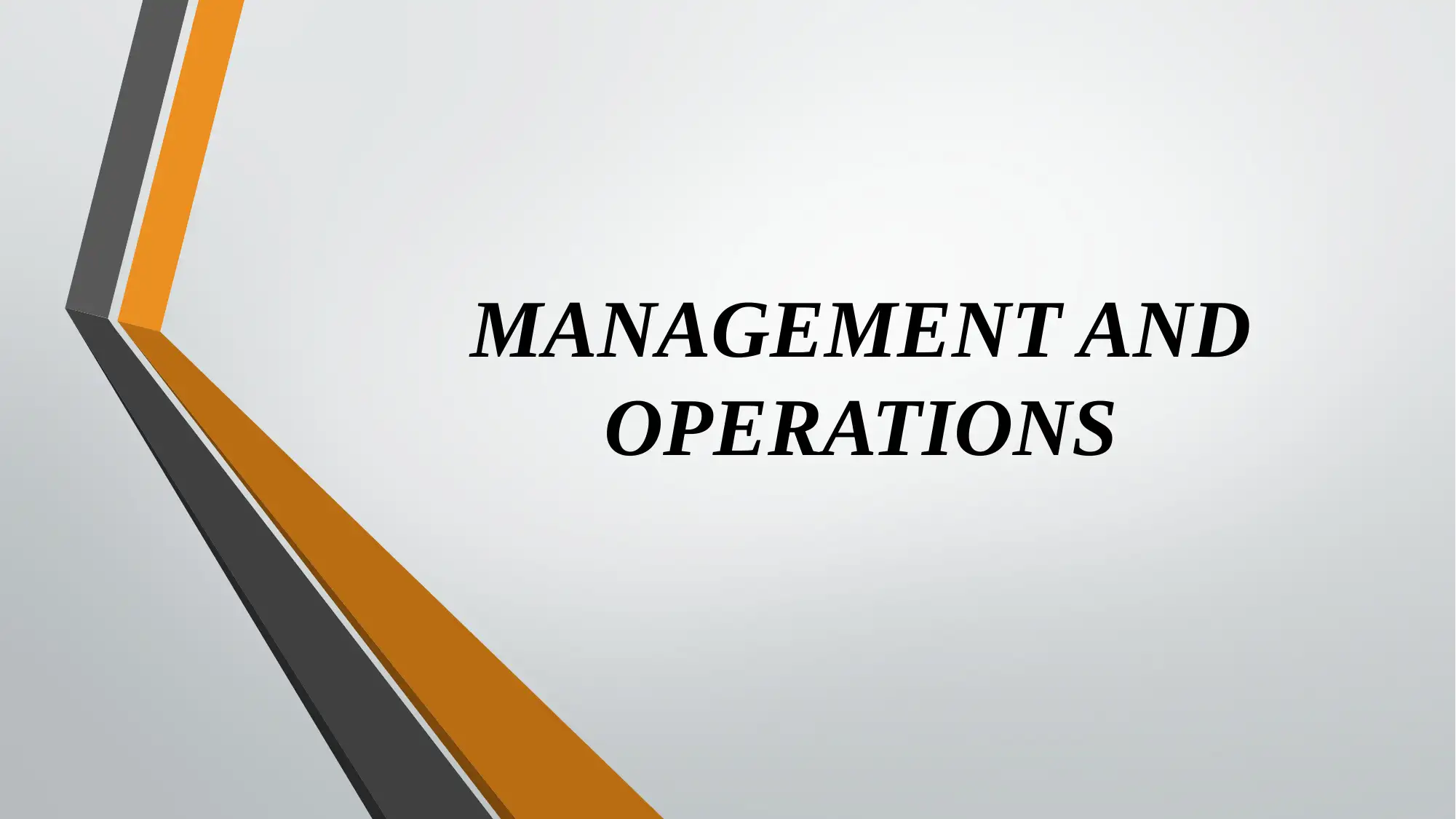
MANAGEMENT AND
OPERATIONS
OPERATIONS
Paraphrase This Document
Need a fresh take? Get an instant paraphrase of this document with our AI Paraphraser
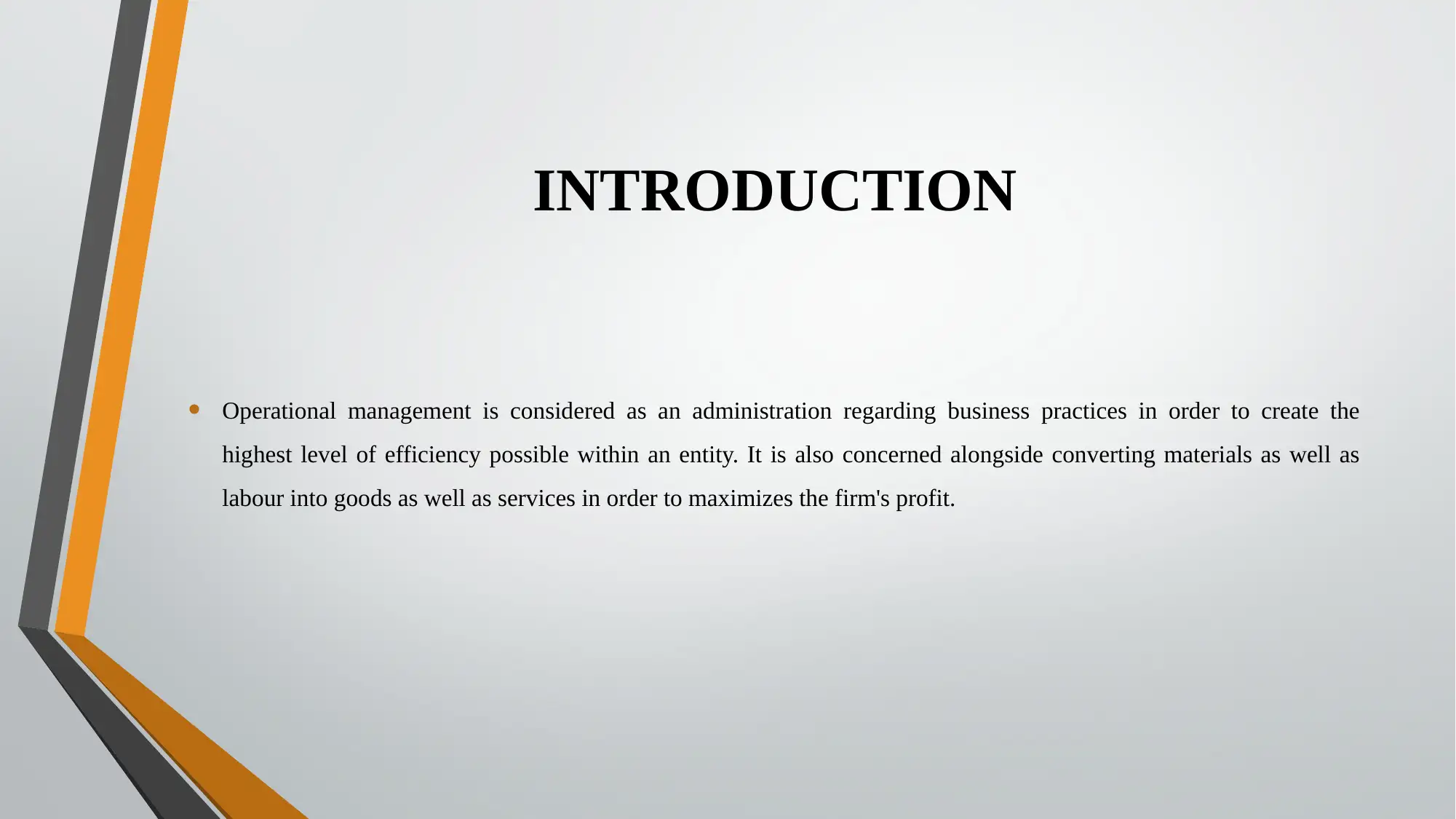
INTRODUCTION
• Operational management is considered as an administration regarding business practices in order to create the
highest level of efficiency possible within an entity. It is also concerned alongside converting materials as well as
labour into goods as well as services in order to maximizes the firm's profit.
• Operational management is considered as an administration regarding business practices in order to create the
highest level of efficiency possible within an entity. It is also concerned alongside converting materials as well as
labour into goods as well as services in order to maximizes the firm's profit.
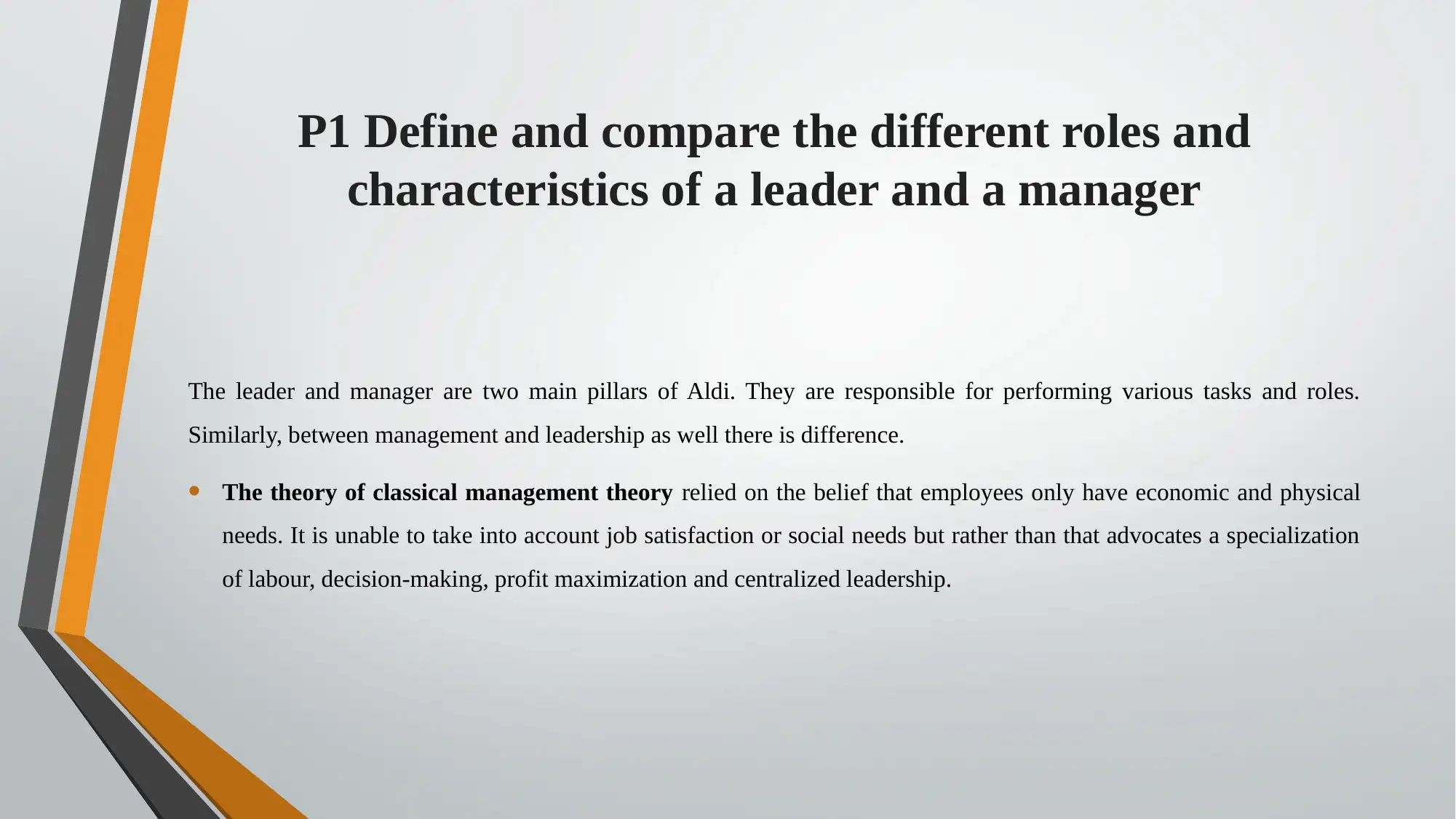
P1 Define and compare the different roles and
characteristics of a leader and a manager
The leader and manager are two main pillars of Aldi. They are responsible for performing various tasks and roles.
Similarly, between management and leadership as well there is difference.
• The theory of classical management theory relied on the belief that employees only have economic and physical
needs. It is unable to take into account job satisfaction or social needs but rather than that advocates a specialization
of labour, decision-making, profit maximization and centralized leadership.
characteristics of a leader and a manager
The leader and manager are two main pillars of Aldi. They are responsible for performing various tasks and roles.
Similarly, between management and leadership as well there is difference.
• The theory of classical management theory relied on the belief that employees only have economic and physical
needs. It is unable to take into account job satisfaction or social needs but rather than that advocates a specialization
of labour, decision-making, profit maximization and centralized leadership.
⊘ This is a preview!⊘
Do you want full access?
Subscribe today to unlock all pages.

Trusted by 1+ million students worldwide
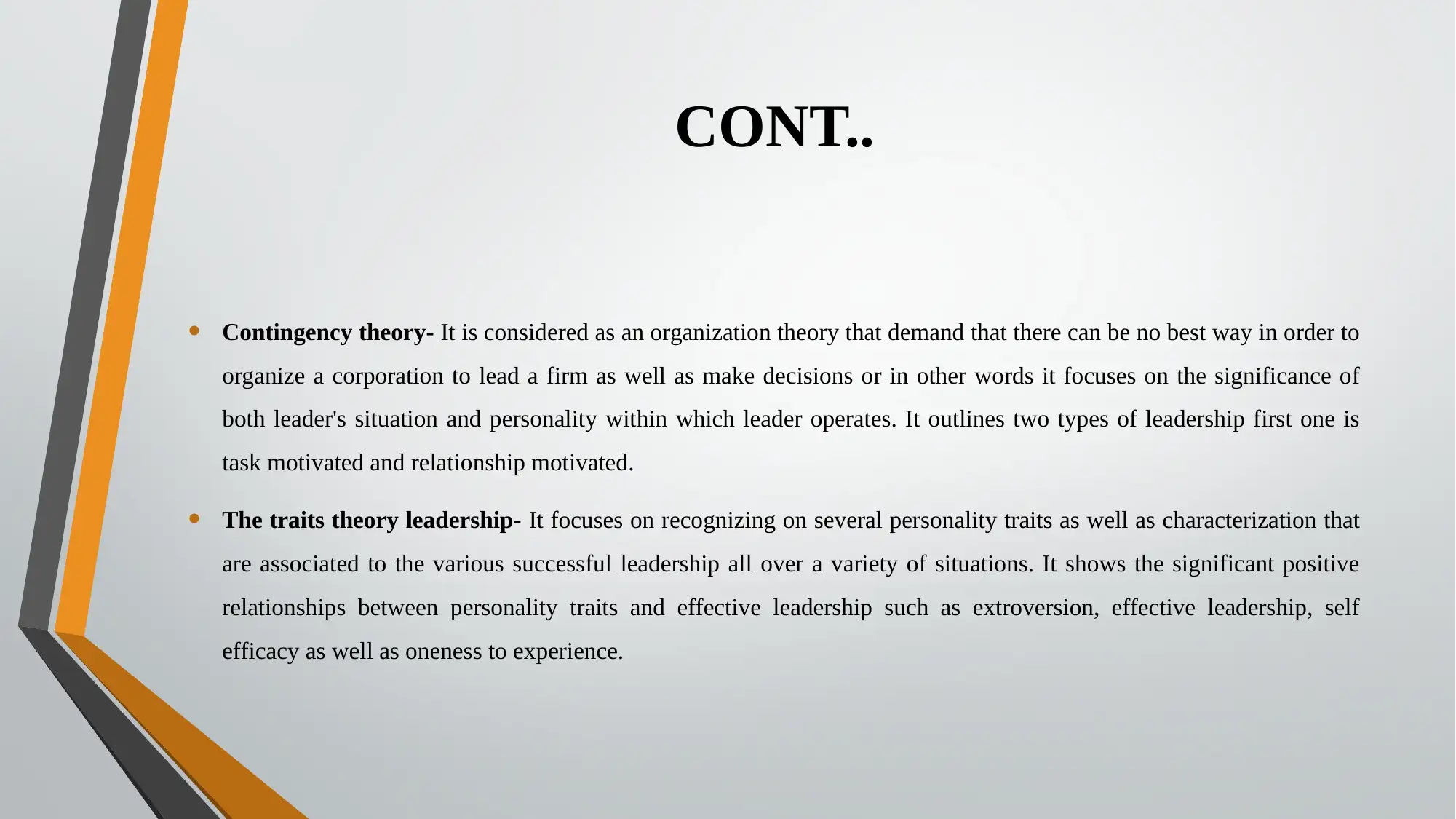
CONT..
• Contingency theory- It is considered as an organization theory that demand that there can be no best way in order to
organize a corporation to lead a firm as well as make decisions or in other words it focuses on the significance of
both leader's situation and personality within which leader operates. It outlines two types of leadership first one is
task motivated and relationship motivated.
• The traits theory leadership- It focuses on recognizing on several personality traits as well as characterization that
are associated to the various successful leadership all over a variety of situations. It shows the significant positive
relationships between personality traits and effective leadership such as extroversion, effective leadership, self
efficacy as well as oneness to experience.
• Contingency theory- It is considered as an organization theory that demand that there can be no best way in order to
organize a corporation to lead a firm as well as make decisions or in other words it focuses on the significance of
both leader's situation and personality within which leader operates. It outlines two types of leadership first one is
task motivated and relationship motivated.
• The traits theory leadership- It focuses on recognizing on several personality traits as well as characterization that
are associated to the various successful leadership all over a variety of situations. It shows the significant positive
relationships between personality traits and effective leadership such as extroversion, effective leadership, self
efficacy as well as oneness to experience.
Paraphrase This Document
Need a fresh take? Get an instant paraphrase of this document with our AI Paraphraser
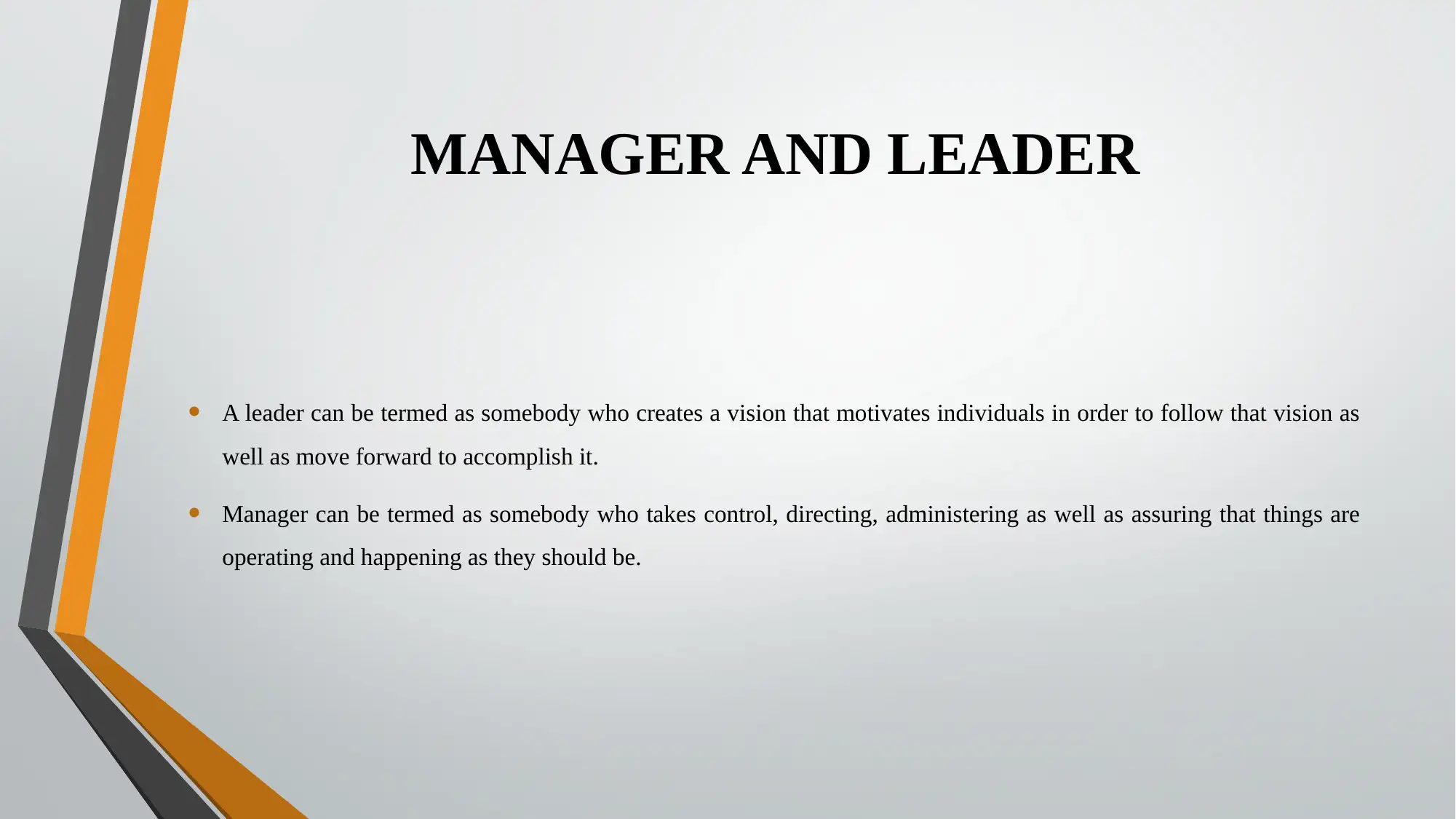
MANAGER AND LEADER
• A leader can be termed as somebody who creates a vision that motivates individuals in order to follow that vision as
well as move forward to accomplish it.
• Manager can be termed as somebody who takes control, directing, administering as well as assuring that things are
operating and happening as they should be.
• A leader can be termed as somebody who creates a vision that motivates individuals in order to follow that vision as
well as move forward to accomplish it.
• Manager can be termed as somebody who takes control, directing, administering as well as assuring that things are
operating and happening as they should be.
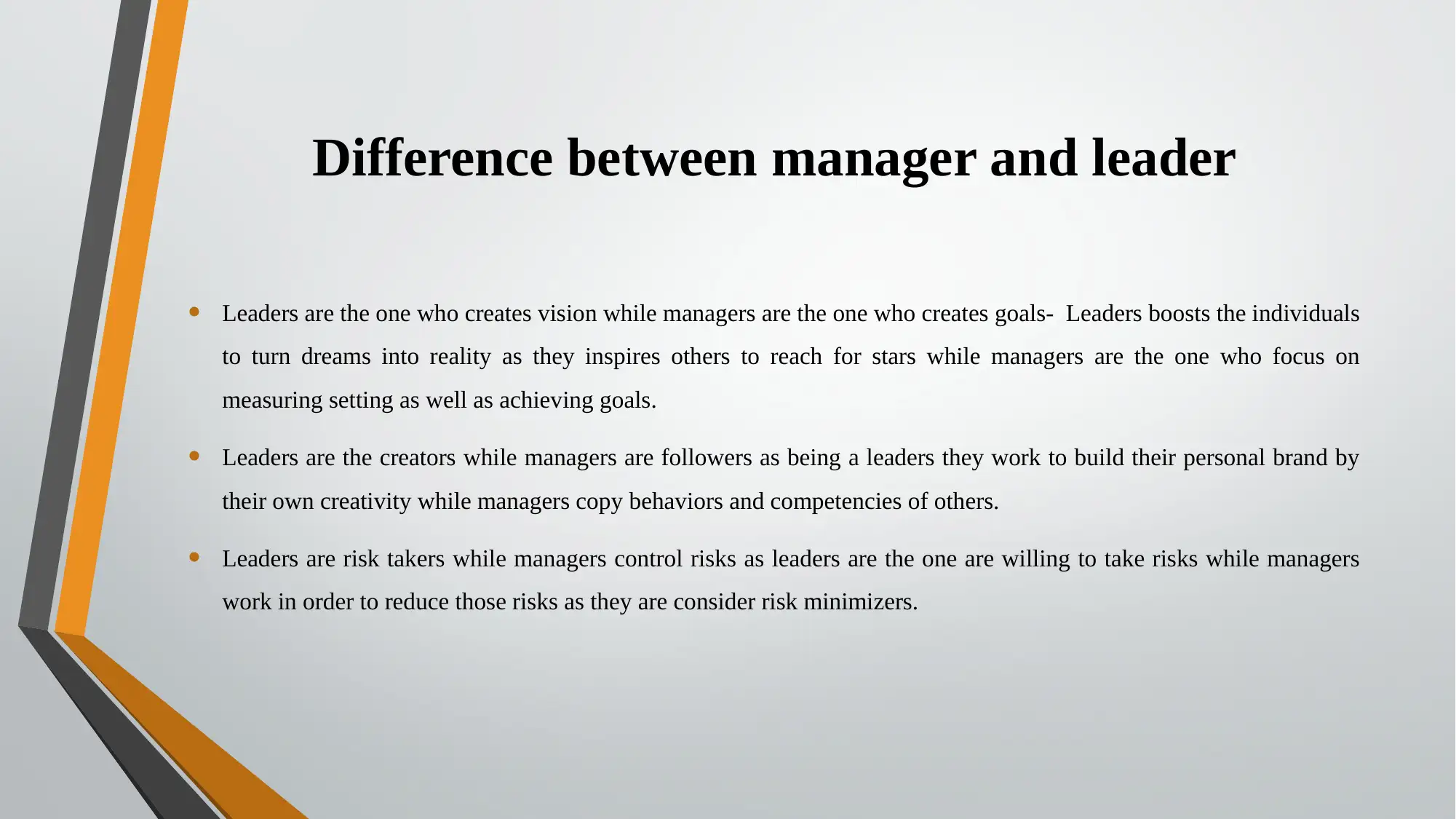
Difference between manager and leader
• Leaders are the one who creates vision while managers are the one who creates goals- Leaders boosts the individuals
to turn dreams into reality as they inspires others to reach for stars while managers are the one who focus on
measuring setting as well as achieving goals.
• Leaders are the creators while managers are followers as being a leaders they work to build their personal brand by
their own creativity while managers copy behaviors and competencies of others.
• Leaders are risk takers while managers control risks as leaders are the one are willing to take risks while managers
work in order to reduce those risks as they are consider risk minimizers.
• Leaders are the one who creates vision while managers are the one who creates goals- Leaders boosts the individuals
to turn dreams into reality as they inspires others to reach for stars while managers are the one who focus on
measuring setting as well as achieving goals.
• Leaders are the creators while managers are followers as being a leaders they work to build their personal brand by
their own creativity while managers copy behaviors and competencies of others.
• Leaders are risk takers while managers control risks as leaders are the one are willing to take risks while managers
work in order to reduce those risks as they are consider risk minimizers.
⊘ This is a preview!⊘
Do you want full access?
Subscribe today to unlock all pages.

Trusted by 1+ million students worldwide
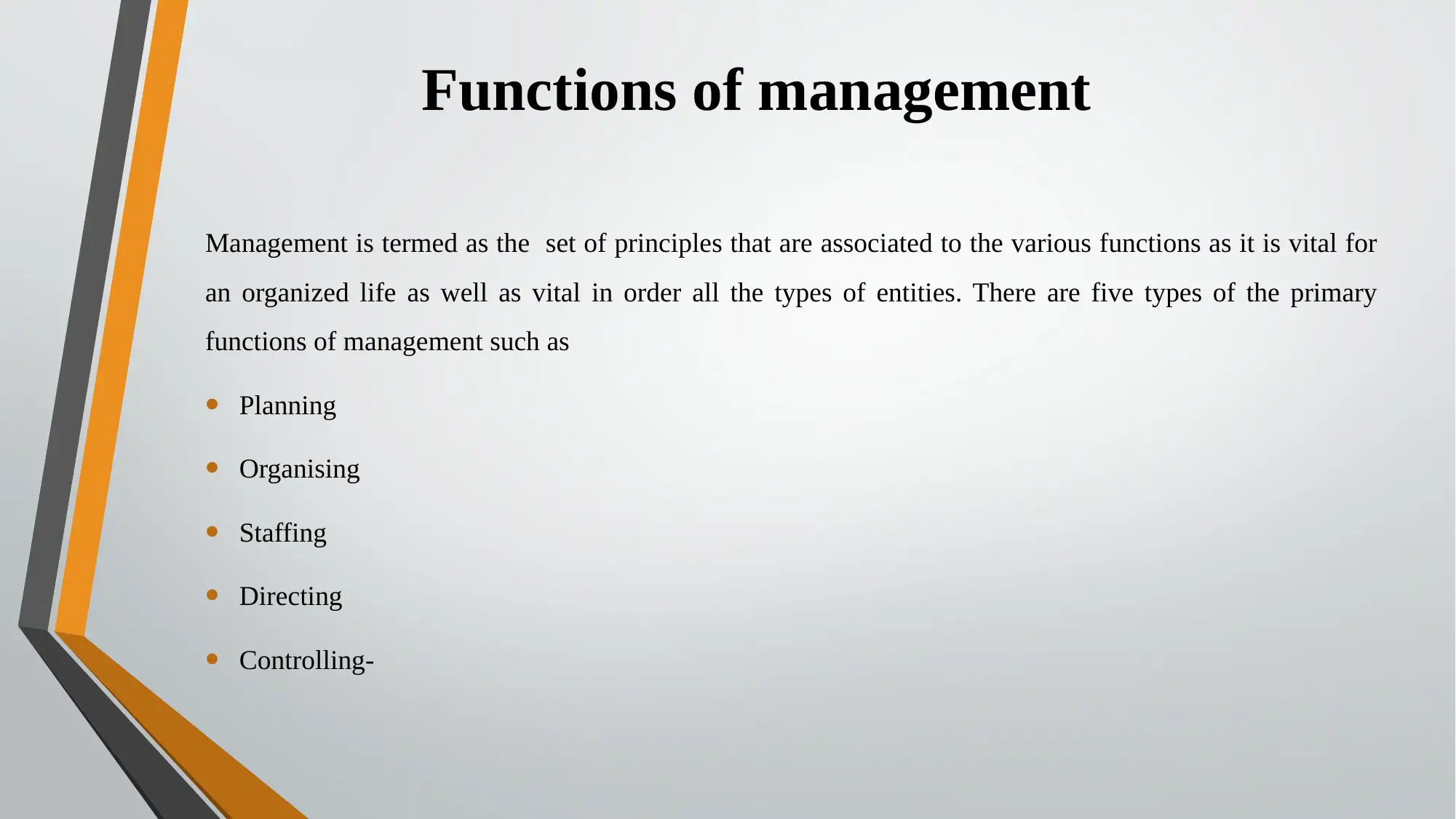
Functions of management
Management is termed as the set of principles that are associated to the various functions as it is vital for
an organized life as well as vital in order all the types of entities. There are five types of the primary
functions of management such as
• Planning
• Organising
• Staffing
• Directing
• Controlling-
Management is termed as the set of principles that are associated to the various functions as it is vital for
an organized life as well as vital in order all the types of entities. There are five types of the primary
functions of management such as
• Planning
• Organising
• Staffing
• Directing
• Controlling-
Paraphrase This Document
Need a fresh take? Get an instant paraphrase of this document with our AI Paraphraser
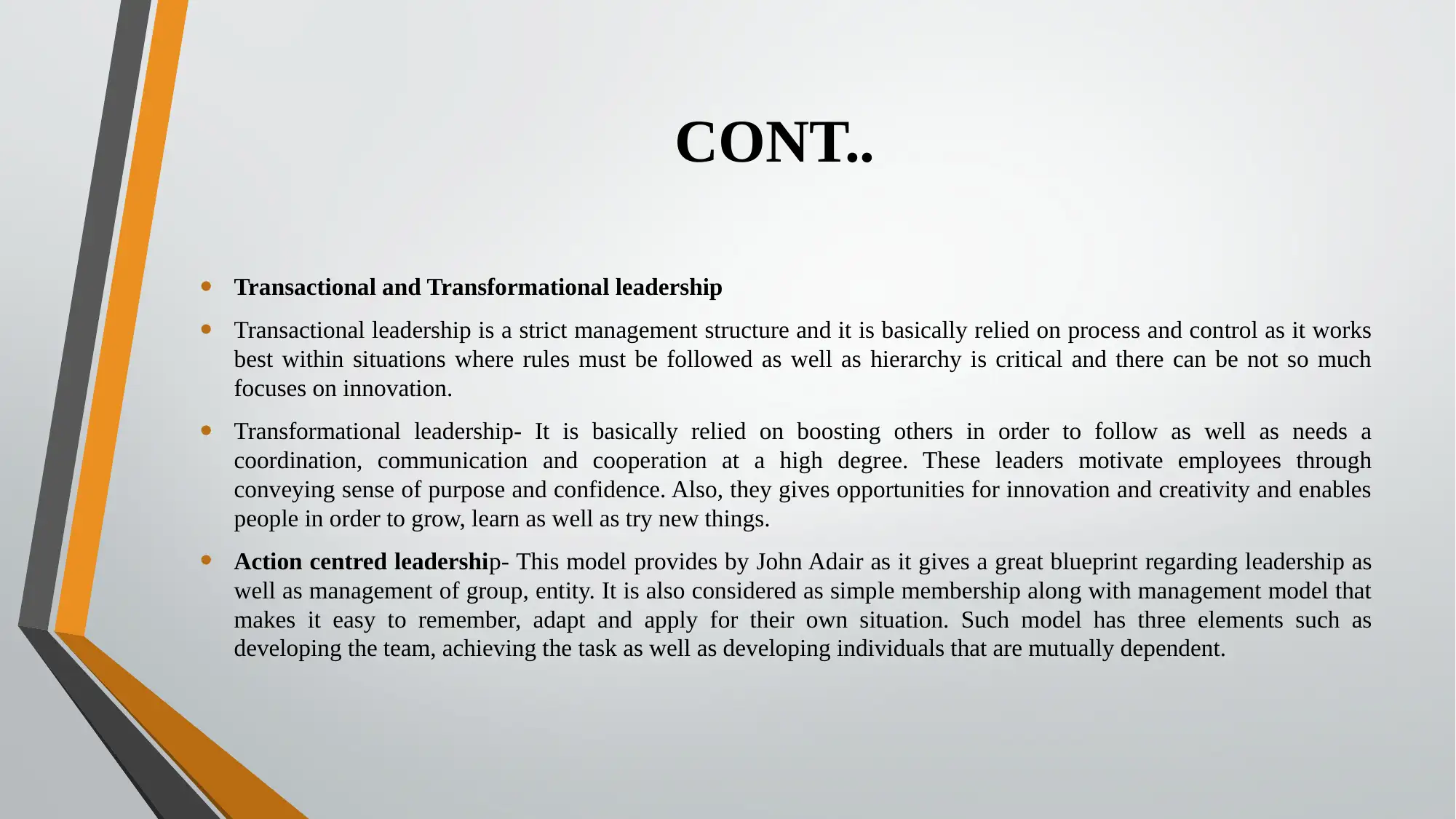
CONT..
• Transactional and Transformational leadership
• Transactional leadership is a strict management structure and it is basically relied on process and control as it works
best within situations where rules must be followed as well as hierarchy is critical and there can be not so much
focuses on innovation.
• Transformational leadership- It is basically relied on boosting others in order to follow as well as needs a
coordination, communication and cooperation at a high degree. These leaders motivate employees through
conveying sense of purpose and confidence. Also, they gives opportunities for innovation and creativity and enables
people in order to grow, learn as well as try new things.
• Action centred leadership- This model provides by John Adair as it gives a great blueprint regarding leadership as
well as management of group, entity. It is also considered as simple membership along with management model that
makes it easy to remember, adapt and apply for their own situation. Such model has three elements such as
developing the team, achieving the task as well as developing individuals that are mutually dependent.
• Transactional and Transformational leadership
• Transactional leadership is a strict management structure and it is basically relied on process and control as it works
best within situations where rules must be followed as well as hierarchy is critical and there can be not so much
focuses on innovation.
• Transformational leadership- It is basically relied on boosting others in order to follow as well as needs a
coordination, communication and cooperation at a high degree. These leaders motivate employees through
conveying sense of purpose and confidence. Also, they gives opportunities for innovation and creativity and enables
people in order to grow, learn as well as try new things.
• Action centred leadership- This model provides by John Adair as it gives a great blueprint regarding leadership as
well as management of group, entity. It is also considered as simple membership along with management model that
makes it easy to remember, adapt and apply for their own situation. Such model has three elements such as
developing the team, achieving the task as well as developing individuals that are mutually dependent.
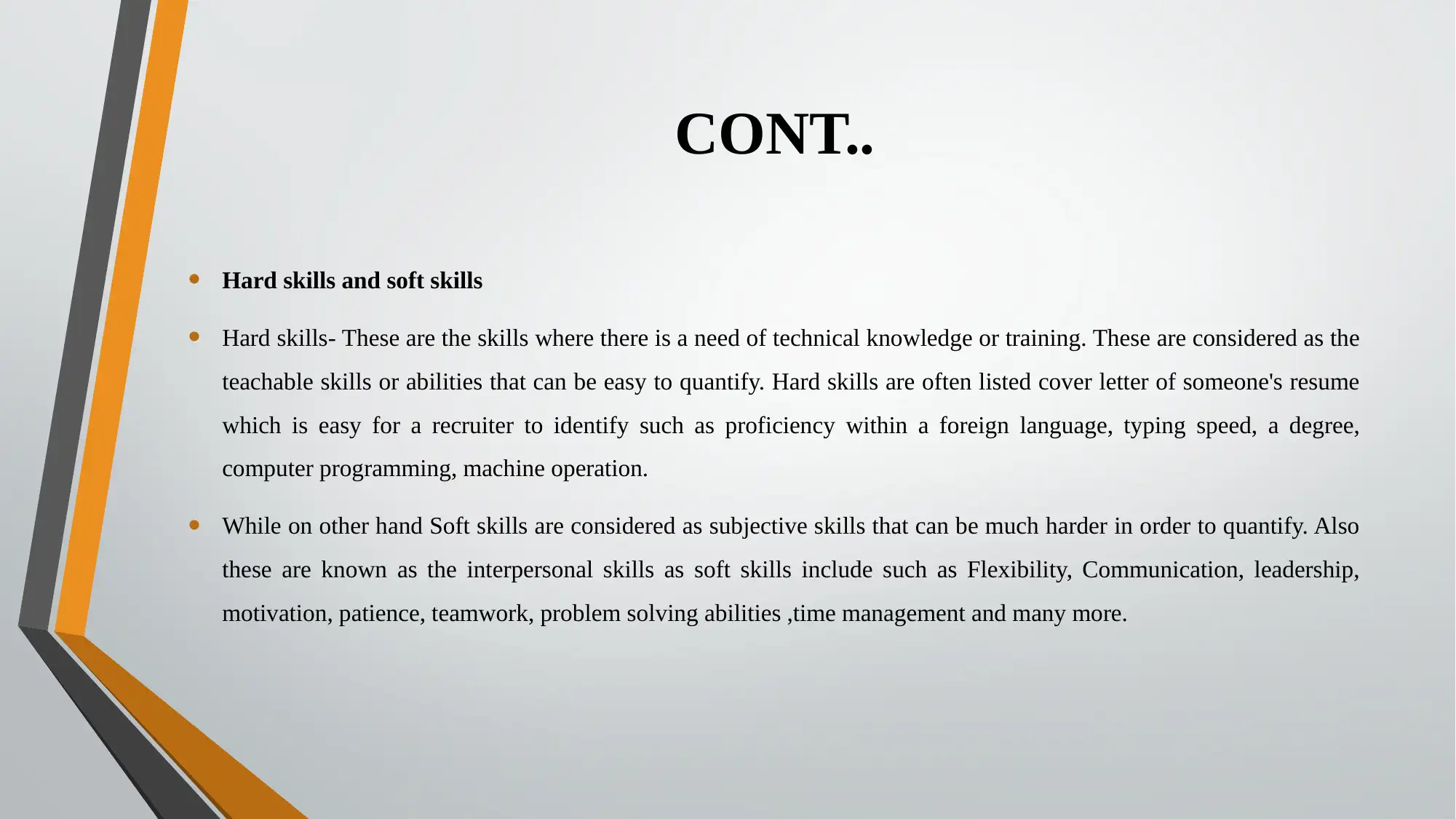
CONT..
• Hard skills and soft skills
• Hard skills- These are the skills where there is a need of technical knowledge or training. These are considered as the
teachable skills or abilities that can be easy to quantify. Hard skills are often listed cover letter of someone's resume
which is easy for a recruiter to identify such as proficiency within a foreign language, typing speed, a degree,
computer programming, machine operation.
• While on other hand Soft skills are considered as subjective skills that can be much harder in order to quantify. Also
these are known as the interpersonal skills as soft skills include such as Flexibility, Communication, leadership,
motivation, patience, teamwork, problem solving abilities ,time management and many more.
• Hard skills and soft skills
• Hard skills- These are the skills where there is a need of technical knowledge or training. These are considered as the
teachable skills or abilities that can be easy to quantify. Hard skills are often listed cover letter of someone's resume
which is easy for a recruiter to identify such as proficiency within a foreign language, typing speed, a degree,
computer programming, machine operation.
• While on other hand Soft skills are considered as subjective skills that can be much harder in order to quantify. Also
these are known as the interpersonal skills as soft skills include such as Flexibility, Communication, leadership,
motivation, patience, teamwork, problem solving abilities ,time management and many more.
⊘ This is a preview!⊘
Do you want full access?
Subscribe today to unlock all pages.

Trusted by 1+ million students worldwide
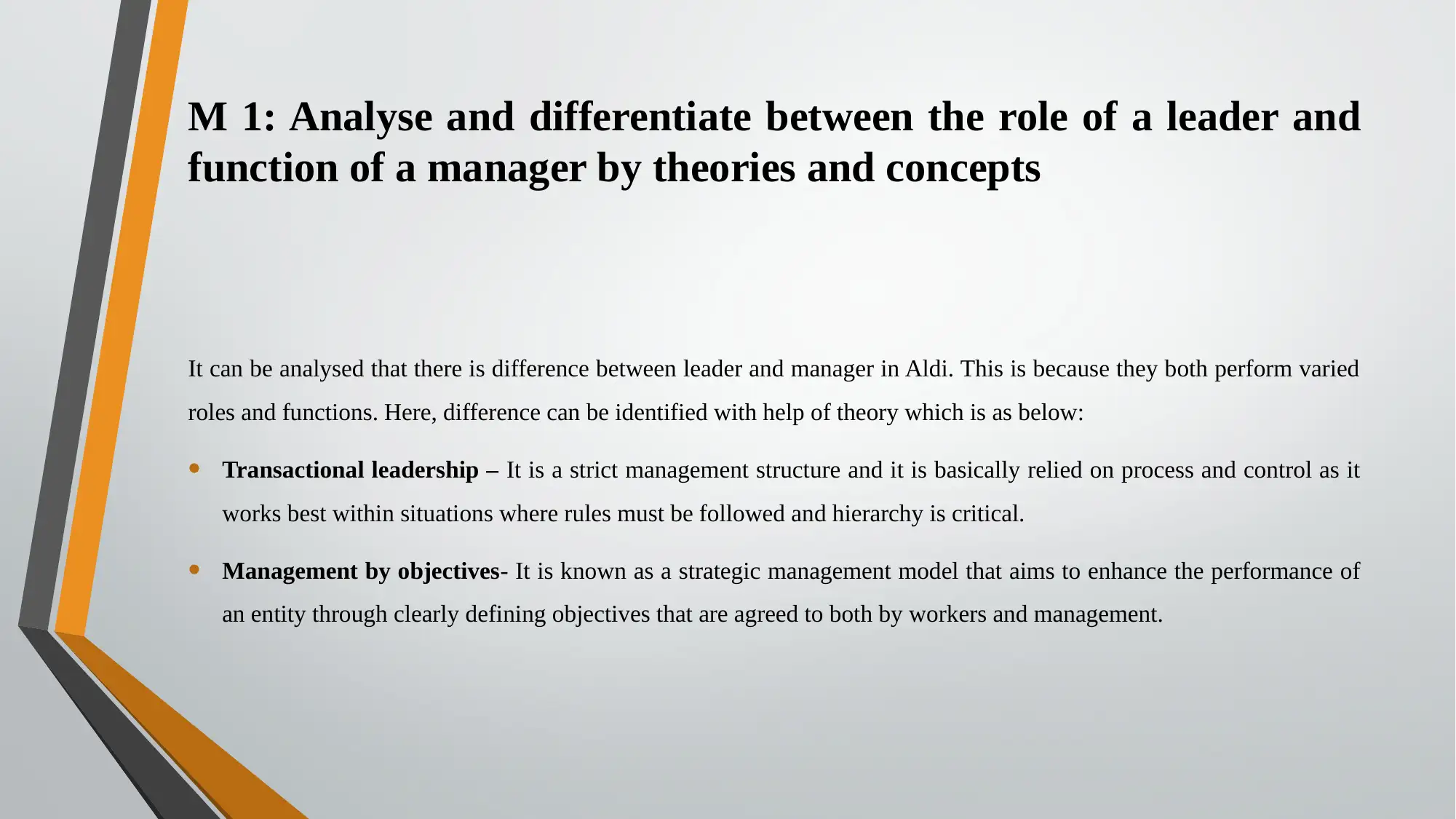
M 1: Analyse and differentiate between the role of a leader and
function of a manager by theories and concepts
It can be analysed that there is difference between leader and manager in Aldi. This is because they both perform varied
roles and functions. Here, difference can be identified with help of theory which is as below:
• Transactional leadership – It is a strict management structure and it is basically relied on process and control as it
works best within situations where rules must be followed and hierarchy is critical.
• Management by objectives- It is known as a strategic management model that aims to enhance the performance of
an entity through clearly defining objectives that are agreed to both by workers and management.
function of a manager by theories and concepts
It can be analysed that there is difference between leader and manager in Aldi. This is because they both perform varied
roles and functions. Here, difference can be identified with help of theory which is as below:
• Transactional leadership – It is a strict management structure and it is basically relied on process and control as it
works best within situations where rules must be followed and hierarchy is critical.
• Management by objectives- It is known as a strategic management model that aims to enhance the performance of
an entity through clearly defining objectives that are agreed to both by workers and management.
Paraphrase This Document
Need a fresh take? Get an instant paraphrase of this document with our AI Paraphraser
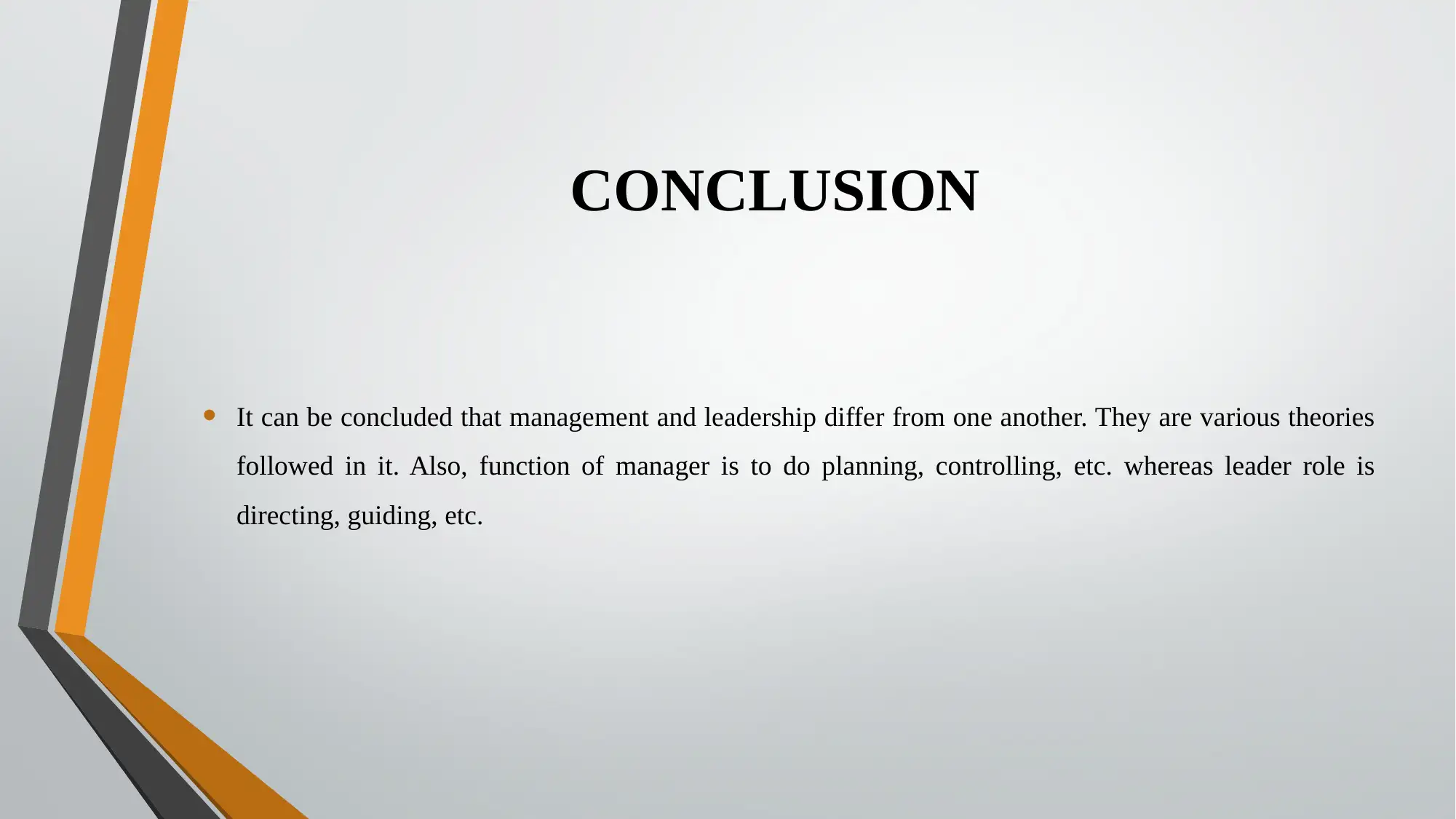
CONCLUSION
• It can be concluded that management and leadership differ from one another. They are various theories
followed in it. Also, function of manager is to do planning, controlling, etc. whereas leader role is
directing, guiding, etc.
• It can be concluded that management and leadership differ from one another. They are various theories
followed in it. Also, function of manager is to do planning, controlling, etc. whereas leader role is
directing, guiding, etc.
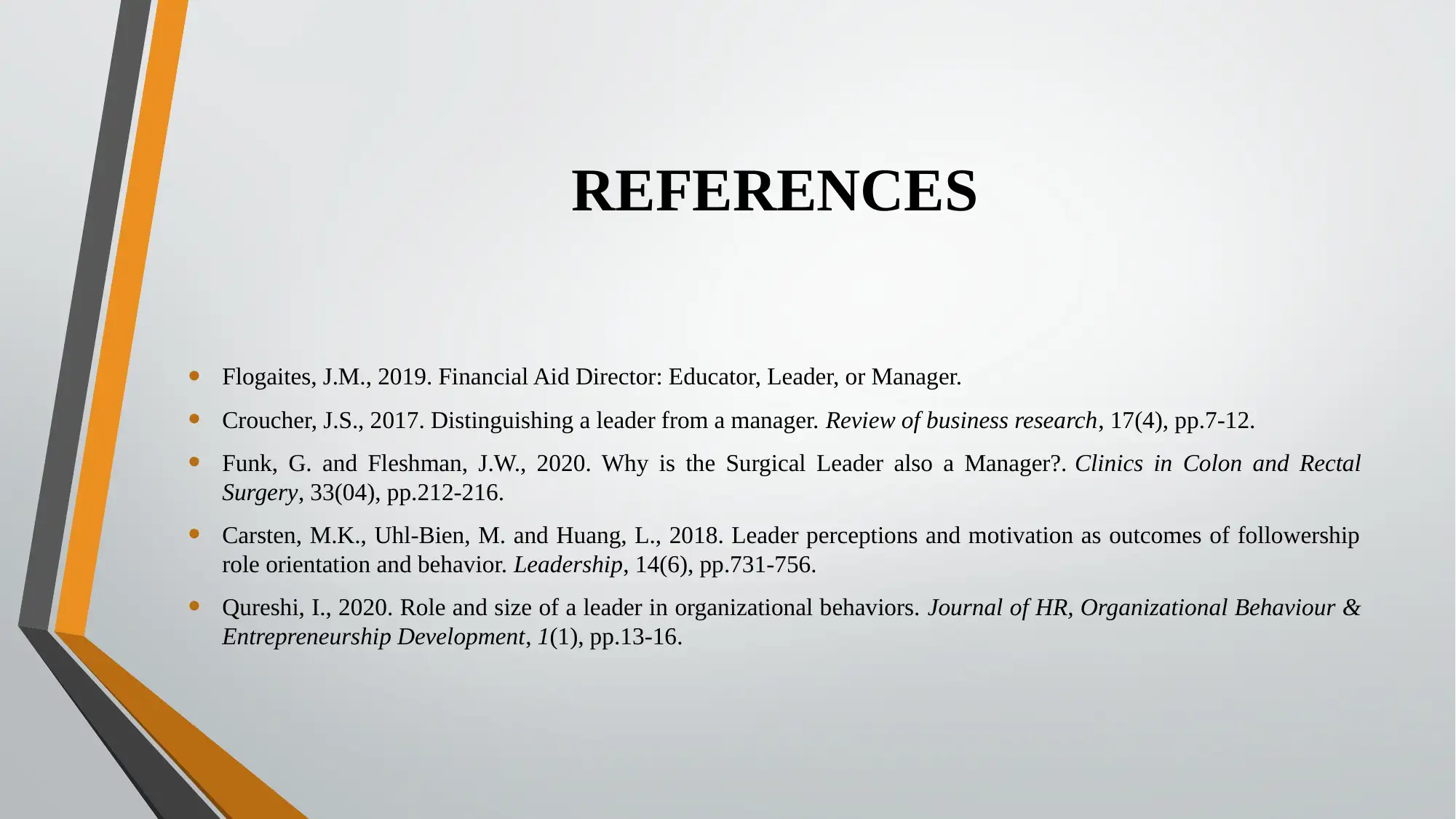
REFERENCES
• Flogaites, J.M., 2019. Financial Aid Director: Educator, Leader, or Manager.
• Croucher, J.S., 2017. Distinguishing a leader from a manager. Review of business research, 17(4), pp.7-12.
• Funk, G. and Fleshman, J.W., 2020. Why is the Surgical Leader also a Manager?. Clinics in Colon and Rectal
Surgery, 33(04), pp.212-216.
• Carsten, M.K., Uhl-Bien, M. and Huang, L., 2018. Leader perceptions and motivation as outcomes of followership
role orientation and behavior. Leadership, 14(6), pp.731-756.
• Qureshi, I., 2020. Role and size of a leader in organizational behaviors. Journal of HR, Organizational Behaviour &
Entrepreneurship Development, 1(1), pp.13-16.
• Flogaites, J.M., 2019. Financial Aid Director: Educator, Leader, or Manager.
• Croucher, J.S., 2017. Distinguishing a leader from a manager. Review of business research, 17(4), pp.7-12.
• Funk, G. and Fleshman, J.W., 2020. Why is the Surgical Leader also a Manager?. Clinics in Colon and Rectal
Surgery, 33(04), pp.212-216.
• Carsten, M.K., Uhl-Bien, M. and Huang, L., 2018. Leader perceptions and motivation as outcomes of followership
role orientation and behavior. Leadership, 14(6), pp.731-756.
• Qureshi, I., 2020. Role and size of a leader in organizational behaviors. Journal of HR, Organizational Behaviour &
Entrepreneurship Development, 1(1), pp.13-16.
⊘ This is a preview!⊘
Do you want full access?
Subscribe today to unlock all pages.

Trusted by 1+ million students worldwide
1 out of 13
Related Documents
Your All-in-One AI-Powered Toolkit for Academic Success.
+13062052269
info@desklib.com
Available 24*7 on WhatsApp / Email
![[object Object]](/_next/static/media/star-bottom.7253800d.svg)
Unlock your academic potential
Copyright © 2020–2025 A2Z Services. All Rights Reserved. Developed and managed by ZUCOL.





